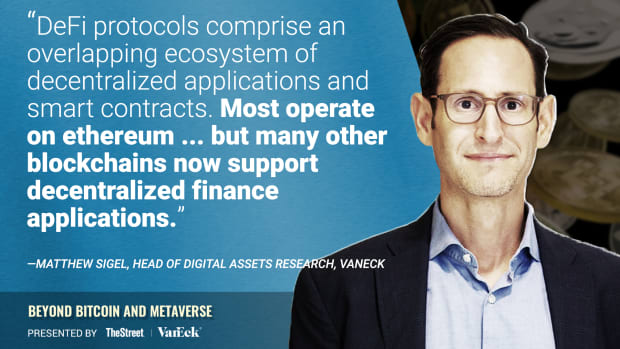
It can be challenging to sort out the crypto world. The crypto categorization schemes that include: store of value, the Metaverse, DeFi, infrastructure applications, smart contracts, and more.
In the video above, Matthew Sigel, Head of Digital Assets Research, at VanEck, discusses the fast-moving sector of DeFi, its subcategories, how it works, and why it is taking market share from both centralized crypto exchanges and the broader financial system.
Sigel says while there are many uncertainties in this fast-moving space (regulatory, technological) VanEck believes that the underlying innovation (faster, cheaper, more frictionless value transfer across the world) is an innovation that “isn’t going to slow down anytime soon.”
Watch a preview: Crypto Categorization: Bitcoin, NFTs, Metaverse, and More
The conversation is part of TheStreet’s webinar on crypto categorization, brought to you by VanEck.
WATCH BELOW: Beyond Bitcoin and Metaverse: Crypto Categories Investors Should Know – FREE Webinar
Editor’s Note: The webinar was recorded on January 28, 2021.
Video Transcript:
Decentralized Finance (DeFi) Explained
Bob Lang: The streets crypto editor calls DeFi the next big thing and a real game-changer. Do you agree with that and how so?
Matthew Sigel: Decentralized Finance protocols (DeFi) are essentially software programs that run on top of another cryptocurrency. And they use a combination of that protocols asset as a means to automate a financial service. So DeFi protocols connect lenders and borrowers, buyers and sellers, without requiring a centralized institution.
DeFi protocols comprise an overlapping ecosystem of decentralized applications and smart contracts. Most operate on ethereum, which is the largest open-source blockchain smart contract platform, but many other blockchains now support decentralized finance applications.
Bob Lang: Let’s talk about DeFi protocols, which can be divided into several subcategories. What are they, and can you give us some examples of this?
DeFi Protocol Classification Explained
Mathew Sigel: DeFi protocols include subcategories such as decentralized exchanges like Uniswap, lending and borrowing platforms like Compound and Aave, derivatives exchanges like Synthetix, asset managers like Mirror or Numeraire, insurance protocols like Nexus, and then all those protocols that aggregate all of those services together, like Yearn Finance. It’s really a fast-moving sector with a lot of changes, and we hope that this classification and subcategory model will give investors a better idea of what types of coins are working and what types of coins are underperforming. And that’ll help capital get allocated more efficiently in the marketplace.
DeFi Protocol Subcategories
- Decentralized exchanges, or DEXs (Uniswap, 0x)
- Lending/borrowing platforms (Compound, Aave)
- Derivatives (Synthetix)
- Asset management (Mirror, Numeraire)
- Insurance (Nexus)
- Aggregators (Yearn Finance)
- Asset-backed reserves (Olumpus Dao)
DeFi Pros and Cons
Bob Lang: What are some of the unresolved challenges that are facing DeFi? Some say this is a chance to rebuild finance from the ground up, and would you agree with that?
Mathew Sigel: DeFi platforms enable buyers and sellers to find each other online without a centralized exchange or intermediary taking a large commission. And because it’s a cheaper and faster and less censored way to transact, decentralized finance has been taking a lot of market share from both centralized crypto exchanges and the broader financial system at large. Now, there are a lot of uncertainties about the space still, regulatory uncertainty, technological uncertainty. But the underlying innovation faster, cheaper, more frictionless value transfer across the world 365, 24/7, that’s an innovation, a technological innovation, that we don’t think is going to slow down anytime soon.
Watch | More FREE webinars on TheStreet and our partners at VanEck:
Editor’s Note: TheStreet’s Zach Faulds produced this video.
This news is republished from another source. You can check the original article here


Be the first to comment